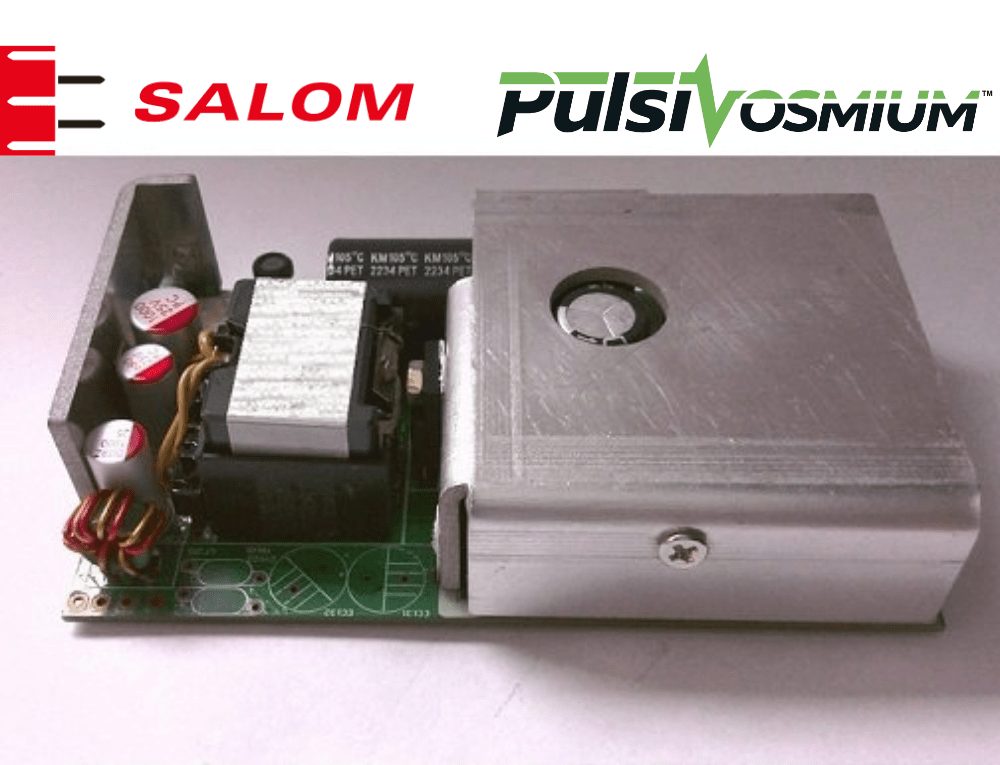
As a leader in power solutions for consumer electronics applications, Salom is very excited to announce a new 150W PSU platform based on Pulsiv Osmium™ technology. Pulsiv has developed an entirely new method of converting AC to DC that enhances conventional flyback topologies to replace more expensive LLC solutions in compact power supplies that deliver an astonishing flat efficiency profile with no inrush current at both hi and low-line input voltage!
Explains CEO Darrel Kingham: “Collaborating with Salom has shown what’s possible when an innovative power supply company deploys Pulsiv OSMIUM technology. Our combined expertise has already achieved results beyond original expectations and there’s still scope for further optimisation. Salom’s unique platform delivers consistently high efficiency while reducing system cost and brings the electronics industry one step closer to making sustainable product design the default choice.”
Typical PSU topologies deliver peak efficiency towards full load, dropping away at lighter loads. When trying to comply with the European Commission ‘Eco Design’ Regulation (EC) No 278/2009*, low power efficiencies often compromise average efficiency. The power industry continues to improve average efficiency by engineering solutions that focus on increasing peak efficiency, even though typical applications spend most of time operating at lighter loads. This is why many power supplies specify peak loads that can only be supported for a short duration. Salom is taking a fresh approach by using Pulsiv OSMIUM to deliver a flat efficiency profile from 10W all the way through to 150W without using GaN or other costly ancillary components!
When power supply usage is modelled with a profile that assumes 10% of time spent at each load level, significant power savings are clearly possible compared to a typical flyback architecture and at lighter loads vs a typical LLC architecture, especially at low-line voltage. In both cases, the overall losses are reduced and improvements become more pronounced during operation at lighter loads!
The importance of this architecture and reduction in power loss over the whole load range cannot be understated for applications with a variable load, as this potentially means;
· Lower product cost: This innovative architecture can be used to cost reduce complex resonant PSU architectures.
· Lower running cost (cost of ownership): With a variable load profile, lower losses at lighter loads will result in reduced input power.
· Reduced Carbon Footprint: Reduced losses result in reduced carbon footprint
· Greater PSU Reliability / Longer PSU Lifetime: Reduced losses result in lower operating temperatures which extends product life
· Improved Supply Chain management: A single PSU can now be used to support multiple applications rather than an optimised psu for each.
If you’re a leader in sustainable consumer electronics and are looking for a complementary sustainable power solution or would like to better understand how this technology could benefit your specific application, come talk to us and we would be happy to share further information on this highly innovative solution.
Andy Richardson – CEng MIET , Vice President Business Development, Salom Europe Ltd
About Salom: Salom is a leading global manufacturer of power supplies for consumer electronics products. As a manufacturing partner for global brands, Salom has produced in excess of 3Bn power suppliers since our formation. Salom products are trusted by some of the most successful electronics companies in the world, quietly and efficiently powering devices across the globe for more than 50 years.
* Published 6 April 2009 for implementing Directive 2005/32/EC of the European Parliament and of the Council with regard to ecodesign requirements for no-load condition electric power consumption and average active efficiency of external power supplies.

